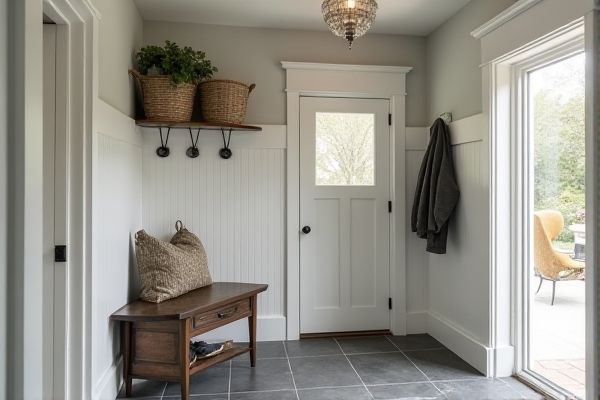
Slate mudroom flooring offers natural durability and unique texture, while porcelain provides exceptional water resistance and low maintenance. Explore this article to determine which option best suits your mudroom's style and functional needs.
Table of Comparison
| Feature | Mudroom Slate | Porcelain |
|---|---|---|
| Material | Natural stone | Manufactured ceramic |
| Durability | High, resistant to cracks and chips | Very high, highly resistant to wear |
| Water Resistance | Moderate, requires sealing | Excellent, waterproof |
| Slip Resistance | Good, textured surface | Varies, can be slip-resistant |
| Maintenance | Sealing recommended, regular cleaning | Low maintenance, easy to clean |
| Appearance | Natural, unique texture and color variations | Consistent patterns and colors |
| Cost | Moderate to high | Moderate |
| Installation | Labor-intensive, requires skilled installation | Relatively easy to install |
| Best Use | Rustic, natural-looking mudrooms | Modern and versatile mudroom flooring |
Introduction to Mudroom Flooring Options
Mudroom flooring options often include slate and porcelain, each offering unique benefits for durability and style. Slate provides a natural, slip-resistant surface ideal for wet or muddy conditions, while porcelain offers a highly durable, low-maintenance alternative with a wide variety of design choices. Choosing the right material ensures your mudroom withstands heavy traffic and moisture while complementing your home's aesthetic.
What is Slate Flooring?
Slate flooring is a natural stone material formed from volcanic ash and clay, known for its durability, unique texture, and rich color variations including gray, green, and rust hues. It offers excellent slip resistance and withstands heavy foot traffic, making it a popular choice for mudrooms where both functionality and aesthetics are important. Compared to porcelain, slate provides a more organic look and higher natural variation, though it typically requires more maintenance to prevent staining and chipping.
What is Porcelain Tile Flooring?
Porcelain tile flooring is a dense, durable ceramic material made from refined clay and fired at high temperatures, resulting in low water absorption and superior strength. It offers exceptional resistance to scratches, stains, and moisture, making it ideal for mudrooms that experience heavy foot traffic and exposure to dirt. Compared to slate, porcelain tiles require less maintenance and provide a wide range of colors and styles while mimicking natural stone aesthetics.
Aesthetic Appeal: Slate vs Porcelain
Slate offers a natural, textured aesthetic with rich, earthy tones that bring warmth and rustic charm to your mudroom. Porcelain provides a sleek, uniform appearance with versatile color options and patterns that mimic natural stone while being easier to maintain. Your choice between slate and porcelain depends on whether you prioritize authentic natural beauty or modern, low-maintenance design.
Durability and Longevity Comparison
Slate mudroom flooring offers exceptional durability due to its natural stone composition, resisting scratches, chips, and heavy foot traffic for decades with minimal maintenance. Porcelain tiles, made from dense ceramic clay, provide high resistance to wear, moisture, and stains, maintaining their appearance and structural integrity over time. Both materials ensure longevity, but porcelain's uniform hardness and water resistance often result in a longer lifespan in high-moisture mudroom environments.
Water and Stain Resistance in Mudrooms
Slate offers natural water resistance and durability, making it a solid choice for mudrooms prone to moisture and dirt. Porcelain tiles excel in water and stain resistance due to their non-porous surface and dense composition, providing superior protection against spills and mud tracked indoors. Your decision between slate and porcelain should consider the level of maintenance you're willing to perform, as porcelain generally requires less upkeep for maintaining its pristine appearance.
Maintenance Requirements for Each Material
Mudroom slate requires regular sealing to protect against moisture and stains, with routine sweeping and mopping to prevent dirt buildup. Porcelain tiles offer lower maintenance, being highly resistant to water, stains, and scratches, needing only occasional cleaning with mild detergent. Both materials benefit from prompt spill cleanup, but porcelain's durable surface makes it more suitable for high-traffic mudrooms with minimal upkeep.
Cost Comparison: Slate vs Porcelain
Slate flooring for mudrooms typically costs between $4 to $8 per square foot, reflecting its natural stone durability and unique texture, while porcelain tiles range from $3 to $7 per square foot, often providing a more budget-friendly option with a wide variety of styles. Installation expenses can be higher for slate due to the need for specialized labor and potential subfloor preparation, whereas porcelain's lighter weight and uniformity generally allow for easier, less costly installation. Your choice depends on balancing initial material costs with long-term durability and maintenance considerations, where porcelain may offer a cost-effective, low-maintenance alternative to natural slate.
Installation Process and Considerations
Mudroom slate requires careful installation due to its natural stone texture and weight, often needing a reinforced subfloor and professional sealing to prevent moisture damage. Porcelain tiles offer a more straightforward installation process with consistent sizing and lower maintenance, making them suitable for DIY projects and high-traffic mudrooms. Consider your skill level and long-term durability needs when choosing between slate's authentic appearance and porcelain's ease of use for your mudroom flooring.
Which Mudroom Flooring is Right for You?
Mudroom slate flooring offers natural stone durability, unique textures, and superior slip resistance, making it ideal for heavy-traffic areas prone to moisture and dirt. Porcelain tile mimics slate's appearance with enhanced stain resistance, easier maintenance, and greater affordability, suiting homeowners seeking low-maintenance, stylish mudroom solutions. Selecting between mudroom slate and porcelain depends on priorities like budget, upkeep requirements, and desired aesthetic, ensuring long-lasting performance tailored to your lifestyle.
 homyna.com
homyna.com